Discover the Best Mountain Bike Stems for Every Rider
Mountain biking is an exciting and adventurous activity that demands not just ability and experience, but also the proper equipment. The stem is one of the most significant pieces of equipment for a mountain cyclist. The stem connects the handlebars to the fork and is crucial to your bike’s overall performance and safety. This blog post will go over the best mountain bike stems on the market and the aspects to consider when purchasing one.
What are the Best Mountain Bike Stems?
Here are my top picks of the best mountain bike stems you can choose to install for your bike.
1. FIFTY-FIFTY Mountain Bike Stem ($54.99)
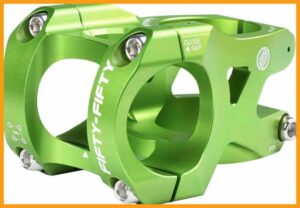
The FIFTY-FIFTY Mountain Bike Stem is a high-end stem for serious mountain cyclists. This stem, made of 6061T6 aluminum and fully manufactured using CNC technology, is designed to be extremely lightweight, weighing only 132g. This is accomplished through a mix of CNC work that eliminates every gram of excess weight and FEA throughout development, which ensures that the stem is as light as possible without sacrificing strength and longevity. The stem is compatible with a wide range of mountain bike forks and handlebars due to its 28.6mm (1-1/8″) steerer tube diameter and 31.8mm (1-1/4″) handlebar diameter.
The 35mm stem has a 0-degree rise and provides a comfortable and stable riding position. The Close Gap face plate design makes the installation of this 31.8mm stem easy with the proper bolt-tightening torque, and the Four bolt bar clamp secures the bar in place, delivering a safe and stable ride. Overall, the FIFTY-FIFTY Mountain Bike Stem is a great choice for mountain cyclists searching for a lightweight, sturdy, and simple-to-install stem that offers a comfortable and secure riding posture.
2. Ztto Mountain Bike Stem ($22.99)
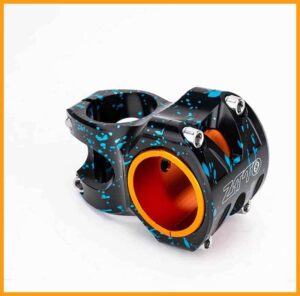
The Ztto Mountain Bike Stem is an adaptable and long-lasting option for every mountain biker. This stem is compatible with a wide range of bikes, with a bar bore clamp diameter of 31.8mm (1-1/4″) or 35mm(1-3/8″) and a steerer tube diameter of 28.6mm (1-1/8″). With a stack height of 40mm and a stem length of 50mm, it fits most mountain bikes.
The stem has a shim that allows it to be used as either 31.8mm or 35mm, depending on your bike’s bar bore clamp diameter. This increased adaptability gives you additional possibilities for personalizing your ride.
The Ztto stem is manufactured utilizing CNC technology, resulting in a lightweight design. With a weight of only 146g, this stem will not drag you down on your rides.
The Ztto stem’s distinctive sectional design provides the torsional rigidity demanded by mountain cyclists, giving you the confidence to tackle any terrain. The chambered burly bar clamp zone reduces stress risers and increases fatigue life in handlebars, making it a durable and long-lasting option.
Installing the Ztto stem is simple; simply connect it to the original front fork stem and secure the fork rod and stem with bolt rods. It’s ideal for do-it-yourself projects, retrofitting, and upgrading motorcycles. With more hues available, you’re likely to find one that complements the style of your bike.
3. PACYTION Mountain Bike Stem ($19.99)
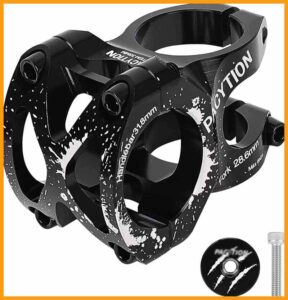
The PACYTION Mountain Bike Stem will enhance your off-road riding experience. This robust, rust-resistant stem is made of durable aluminum alloy and treated with anti-cathode oxidation. Because of its distinctive hollow-out form, this stem is ultra-lightweight, providing rapid and simple control on even the most challenging maneuvers. This stem is meant to fit smoothly into your bike, with a center distance of 35mm and handlebar and steer tube sizes of 31.8mm and 28.6mm, respectively.
The stem is held in place by six carbon steel screws that have been electrophoresis treated, ensuring that they will not rust and will stay firmly in place during intense rides. A stem cap in the same color as the stem and an Allen wrench for the top cap is also included, making installation and modification a snap. This stem’s sleek and attractive design will not only increase your biking performance but will also improve the overall appearance of your bike.
4. LITEONE Mountain Bike Stem ($15.99)
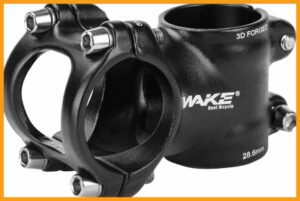
The LITEONE Mountain Bike Stem is a high-performance stem ideal for serious cyclists seeking a lightweight, robust, and simple-to-install modification for their bikes. The hollow form of this stem helps to save weight without losing strength. This stem is made of high-strength CNC machined 6061 T6 aluminum alloy and is designed to resist even the most extreme off-road conditions. This stem is compatible with most road bikes, fixed gear bicycles, mountain bikes, downhill bikes, track bikes, MTBs, and BMXs, with a handlebar diameter of 31.8mm (1-1/4″), a length of 45mm (central distance between the two holes), and a tube diameter of 28.6mm (1-1/8″). The 7-degree angle ensures a natural and comfortable riding posture.
The four-bolt bar clamp secures the bar in place and is simple to install; simply connect it to the existing front fork stem riser. Overall, the LITEONE Mountain Bike Stem is an excellent choice for anyone searching for a high-quality, lightweight, sturdy, and simple-to-install stem.
5. Qikour Mountain Bike Stem ($14.99)
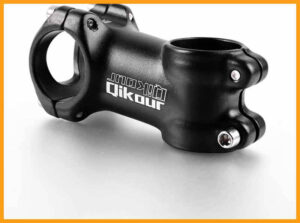
The Qikour Mountain Bike Stem is an excellent complement to the bike of any off-road enthusiast. This stem is made of high-strength aluminum alloy and is designed to survive the most difficult trails. Its well-designed 7-degree angle and length options of 60mm, 80mm, 90mm, 100mm, and 110mm make finding the ideal fit for your bike simple. Simply connect it to your original front fork for installation.
The four-bolt bar clamp secures your handlebar, ensuring a stable ride. Please keep in mind that you may need to install a shim to achieve a suitable fit depending on the thickness of your handlebar. Also, to eliminate any looseness issues, apply glue on the threads for increased security. The Qikour Mountain Bike Stem will make your bike more comfortable and stable on any terrain.
What is a mountain bike stem?
A mountain bike stem is a component that connects a mountain bike’s handlebars to the fork steerer tube. It is an important component of the motorcycle’s front end, providing stability, control, and rider comfort.
The major function of the stem is to secure the handlebars while letting the rider alter their position for maximum comfort and performance. It has a clamping mechanism on one end to hold the handlebars in place and a steerer tube clamp on the other end to attach it to the fork.
Mountain bike stems come in a variety of lengths, angles, and materials to support different riding styles and bike geometry. The length of the stem dictates the reach of the handlebars, which influences the overall handling characteristics of the bike. A shorter stem feels more responsive and agile, whereas a longer stem gives stability at faster speeds.
The angle of the stem, also known as the rise or drop, determines the position of the handlebars in relation to the fork. Depending on the rider’s preference and the terrain, it can be adjusted to produce a more upright or aggressive riding position.
Stems are often made of aluminum alloy, carbon fiber, or a combination of the two, and vary in stiffness, weight, and strength. Some stems also have advanced technology like as vibration dampening or integrated computer mounting.
Consider aspects such as riding style, body proportions, bike frame geometry, and personal preferences for handling characteristics when selecting the proper mountain bike stem. Working with a skilled bike store or professional is critical to ensure you have the right stem for your needs.
What is the proper stem for a mountain bike?
The best stem for a mountain bike depends on the rider’s particular demands and preferences. However, a typical mountain bike stem length is between 50mm and 80mm, with a clamp diameter of 31.8mm. It is critical to select a stem that is compatible with the bike’s frame and handlebars, as well as the rider’s body proportions and riding style.
Furthermore, the stem angle might affect the bike’s handling and stability, thus it’s important to consider this while choosing a stem. To ensure the stem is properly placed and adjusted for the best performance and safety, speak with a professional bike fitter or mechanic.
What are the different types of stems in a mountain bike?
Mountain bike stems come in a variety of styles, including:
- Quill Stem: An older form of the stem that is put into the fork’s steerer tube and secured with a wedge bolt. Quill stems are becoming less prevalent on modern mountain bikes, but they are still used on some vintage or retro bikes.
- Threadless Stem: The threadless stem is the most prevalent form of stem seen on current mountain bikes. It is fastened to the outside of the steerer tube with a series of fasteners. Threadless stems are available in a variety of lengths and angles, allowing riders to personalize their riding posture.
- Adjustable Stem: This sort of stem allows the angle and length of the stem to be adjusted. This is useful for cyclists who wish to try out different riding postures or who ride with other riders.
- Direct Mount Stem: This is a newer style of stem that attaches to the fork crown or steerer tube directly. It is frequently used in conjunction with a handlebar known as a “downhill” or “riser” bar.
- Integrated Stem: A stem that is built into the bike’s steerer tube and headset. This sort of stem is prominent on high-end mountain bikes and can aid in weight reduction and stiffness improvement.
The optimal stem for you will be determined by your riding style, bike configuration, and personal preferences.
What is the advantage of a long mountain bike stem?
Depending on the rider’s tastes and riding style, a long mountain bike stem might bring numerous benefits. Here are some of the potential advantages of adopting a long stem:
- Increased stability: A longer stem can provide the front end of the bike more stability, making it simpler to handle at high speeds or over rough terrain. This can be especially useful for downhill or enduro riding.
- More efficient climbing: A longer stem can put the rider in a more upright position, which can make climbing more efficient. This can aid in reducing fatigue and improving power transfer to the pedals.
- Improved handling: Depending on the rider’s preferences, a longer stem can give improved handling, especially for riders who favor a more stretched-out riding position. This is especially useful for riders who enjoy riding aggressively or prefer a more XC-style riding stance.
It is crucial to note, however, that a longer stem is not always preferable for everyone. It may also have certain disadvantages, such as making the bike less maneuverable in confined areas or over technical terrain. Finally, the optimal stem length will be determined by a number of criteria, including the rider’s body proportions, riding style, and preferences.
How do I know what size of mountain bike stem to buy?
There are a few aspects to consider while selecting the correct size mountain bike stem:
- Riding style: The riding you perform will influence the length of the stem you require. If you ride in rough terrain or downhill, a shorter stem will provide you with more control. If you ride cross-country frequently, a longer stem may be preferable for increased stability.
- Body proportions: Your body proportions, such as height, arm length, and torso length, can influence the stem length you require. A longer stem may help taller riders with longer arms, while a shorter stem may favor shorter riders.
- Bike fit: Your overall bike fit is critical to your comfort and performance. The length of your stem should be set to complement the geometry of your bike and your riding stance.
It’s advisable to check with a bike fitting professional at a local bike shop to establish the ideal stem length for you. They can propose the best stem length for you based on your riding style, body dimensions, and bike fit.
Can I use a mountain bike stem on a road bike?
A mountain bike stem can be used on a road bike, but it may not be the ideal solution for optimal performance and comfort.
Mountain bike stems are shorter and pointed upwards in order to provide a more upright riding stance and better handling on tricky terrain. In contrast, road bike stems are longer and slanted downwards to create a more aerodynamic riding position for speed and efficiency on smooth ground.
When riding a road bike with a mountain bike stem, you may experience a more upright riding position, which can be less aerodynamic and perhaps uncomfortable on extended rides. Furthermore, the shorter stem may impact the bike’s handling and steering.
If you want to use a mountain bike stem on your road bike, you should think about your riding goals and preferences. A mountain bike stem may be a suitable alternative if you value comfort and control over speed and efficiency. A road bike stem, on the other hand, maybe a better choice if you are primarily concerned with performance and speed.
What is the purpose of a mountain bike stem?
A mountain bike stem connects the handlebars to the steerer tube of the fork, allowing the rider to regulate the bike’s direction. The stem is critical to the rider’s overall comfort, control, and riding position on the mountain bike.
Here are some of the primary functions of a mountain bike stem:
- Handlebar Attachment: The stem firmly clamps onto the fork’s steerer tube on one end and serves as a mounting point for the handlebars on the other. It keeps the handlebars firmly in position while riding, allowing the user to steer the bike.
- Steering Control: The stem conveys the rider’s input from the handlebars to the front wheel by linking the handlebars to the fork, providing for accurate steering control. The length and angle of the stem can affect the bike’s responsiveness and handling characteristics.
- Riding Position: The stem also influences the rider’s riding position on the mountain bike. It can be modified to achieve a comfortable and ergonomic riding posture, taking parameters such as reach, height, and personal choice into account. Changing the length and angle of the stem can assist fine-tune the bike’s fit to the rider.
- Control and stability: A well-chosen stem can improve the overall stability and control of the bike. It has an effect on the weight distribution between the front and rear wheels, which influences the bike’s handling qualities. The appropriate stem can improve your bike’s stability during descents, maneuverability on technical trails, and overall control.
Some stems have characteristics that absorb or dampen vibrations, minimizing the transfer of shocks and impacts from the trail to the rider’s hands and upper body. This can help with comfort and fatigue on long rides or on tough terrain.
How does the length of a mountain bike stem affect the bike’s handling?
The length of a mountain bike stem can have a considerable impact on how the bike handles. The stem connects the handlebars to the steerer tube of the fork, dictating the rider’s reach and position on the bike. Here’s how the length of the stem impacts the bike’s handling:
- Reach and Position: A longer stem extends the distance between the saddle and the handlebars, resulting in a more stretched-out riding position. This can benefit riders who want a more aerodynamic and aggressive stance because it moves more weight to the front wheel, enhancing control and steering precision.
- Stability: By extending the wheelbase, a longer stem can improve stability at greater speeds. This can be useful when riding downhill or navigating quick, straight portions of the route. Excessively lengthy stems, on the other hand, may impair maneuverability and make tight turns more difficult.
- Steering Responsiveness: Shorter stems reduce the total reach of the bike, bringing the handlebars closer to the rider. As a result, the rider is more upright, which allows for faster steering response and improved handling. Shorter stems make bikes feel more nimble and agile, making them ideal for tricky and curvy routes.
- Weight Distribution: The weight distribution between the front and back wheels is influenced by the stem length. Longer stems transfer more weight to the front wheel, which improves front-end traction and control, especially on steep descents. Shorter stems, on the other hand, distribute weight more equally between the wheels, which can improve climbing ability and balance.
- Rider Comfort and Fatigue: Stem length influences rider comfort. Longer stems can result in a longer reach, which might put a strain on the back, neck, and shoulders during lengthy rides. Shorter stems, on the other hand, enable a more upright and relaxed stance, which reduces tiredness, especially while riding for long periods of time.
It is crucial to remember that the appropriate stem length varies according to rider preference, body proportions, riding style, and terrain. Experimenting with varied stem lengths can assist riders in finding the best balance of stability, maneuverability, and comfort for their individual demands. To find the optimal stem length for you, speak with a professional bike fitter or seek advice from experienced riders.
What are the different types of mountain bike stems available?
Mountain bike stems come in a variety of styles and designs, each with its own set of features and benefits. Here are some examples of common mountain bike stems:
- Quill Stem: Quill stems are a type of stem that is typically found on vintage or classic mountain bikes. They have a long, threaded quill that goes into the steerer tube of the fork and is locked by a wedge bolt. Quill stems are normally fixed in angle and height adjusted by raising or lowering the stem on the steerer tube.
- Threadless Stem: The most popular form of stem seen on current mountain bikes is the threadless stem. They are made up of a stem that is clamped onto the steerer tube with a number of bolts. Threadless stems are simple to install and allow for height and angle adjustments by adding or removing spacers above or below the stem.
- Riser Stem: A riser stem raises the handlebars higher than a regular stem, creating a more upright riding stance. Riders that prefer a more relaxed and pleasant riding position, such as beginners or those riding on less challenging trails, frequently utilize these stems.
- Adjustable Stem: Adjustable stems allow for on-the-fly changes to the angle and length of the stem. These stems often contain a hinge or pivot point that allows the rider to modify the position of the stem while riding, allowing the rider to adapt to changing riding circumstances or personal preferences.
- Direct Mount Stem: A direct mount stem is one that connects directly to the fork crown or upper crown of a suspension fork. By eliminating the requirement for a steerer tube clamp, they provide better stiffness and control. Direct mount stems are used in downhill and enduro mountain biking, where strength and precision are essential.
- Carbon Fiber Stem: Carbon fiber stems are made of lightweight carbon fiber material, which provides a good mix of strength and weight reduction. They are popular with riders who want to minimize overall bike weight while increasing vibration dampening.
- Short Stem: Due to their impact on handling and mobility, short stems have gained favor in recent years. They shorten the reach and boost the responsiveness of the bike, making it simpler to handle tight and tricky routes. Short stems are widely utilized in cross-country and trail-riding disciplines.
These are just a few of the different varieties of mountain bike stems available on the market. When selecting the best stem for your mountain bike, keep your riding style, terrain, and personal preferences in mind.
How do I choose the right length of mountain bike stem for my bike?
The correct length of the mountain bike stem is critical for attaining a comfortable and effective riding position. The length of the stem controls your reach to the handlebars, which affects your overall balance, control, and handling of the bike. Consider the following considerations while determining the optimal stem length:
- Riding Style and Terrain: The stem length you want may be influenced by your riding style and terrain preferences. A shorter stem gives a quicker steering reaction and increased handling for intense downhill riding or tricky trails. Longer stems are typically preferred for cross-country or endurance riding because they provide more stability and a more stretched-out riding position for effective pedaling.
- Body Proportions: Your body proportions are very important in determining stem length. Your torso length and arm length are the two most important measurements to consider. Shorter stems may be preferred by riders with longer torsos to minimize reach, while longer stems may be preferred by riders with shorter torsos to increase reach. Similarly, riders with longer arms may prefer shorter stems, while riders with shorter arms may prefer longer stems.
- Bike Frame Size: Another item to consider is the frame size of your mountain bike. Larger frame sizes frequently have longer top tubes, which can be offset by employing a shorter stem. Smaller frames, on the other hand, may work well with longer stems to provide a comfortable riding position.
- Personal Preference: In the end, personal preference plays a vital role in determining the appropriate stem length. Some riders prefer to be more upright and calm, while others want to be more aggressive and forward-leaning. Consider experimenting with different stem lengths to achieve the right blend of comfort and control for you.
It’s important to note that stem length is normally measured in millimeters, with typical lengths ranging from 50mm to 120mm or more. If you’re unclear about which length to go with, talking with a professional bike fitter or visiting a local bike shop can provide important advice and help you select the best stem length for your personal needs.
How does the angle of a mountain bike stem affect the riding position?
The angle of a mountain bike stem has a considerable impact on the rider’s riding position and overall comfort. The stem connects the handlebars to the fork steerer tube of the bike, determining the reach and height of the handlebars relative to the rider.
The angle of the stem is commonly known as the “rise” or “angle.” It is measured in degrees and determines the handlebars’ vertical position. Positive (+), zero (0), and negative (-) rise angles are the most frequent for mountain bike stem.
- Positive Rise: A positive rise stem bends upward from the steerer tube. This lifts the handlebars, giving you a more upright riding stance. It is appropriate for riders who want a more relaxed and pleasant riding posture, as it improves visibility and reduces back and neck pain. The positive rise stems are frequently used for leisure and endurance riding.
- Zero Rise: When installed on the steerer tube, a stem with a zero rise angle is parallel to the ground. It maintains a neutral riding position, not dramatically lifting or lowering the handlebars. Cross-country (XC) or trail bikes with zero-rise stems are common, as a balanced and slightly aggressive riding stance is desirable. They offer an excellent balance of comfort and control.
- Negative Rise: A negative rise stem is one that curves downward from the steerer tube. The handlebars are lowered, resulting in a more aggressive and aerodynamic riding position. The negative rise stems are often employed in downhill (DH) and freeride sports, where a forward-leaning position improves control and maneuverability. They are appropriate for riders that choose a more aggressive and performance-oriented riding style.
It is crucial to notice that the stem angle does not totally determine the riding position. Other aspects that influence the overall fit and feel of the bike are stem length, handlebar width, and frame shape. Consider your riding style, tastes, and body proportions when selecting a mountain bike stem, and seek tailored assistance from a qualified bike store or a professional bike fitter.
What materials are mountain bike stems made of, and which is the best?
Mountain bike stems are usually fashioned from a range of materials, each having unique properties and benefits. The following are the most frequent materials used for mountain bike stems:
- Aluminum: Aluminum is a lightweight, inexpensive material that is extensively utilized in mountain bike stems. It has a strong strength-to-weight ratio and is relatively long-lasting. Aluminum stems are used on entry-level and mid-level mountain bikes.
- Carbon Fiber: Carbon fiber stems are lightweight and have good vibration-dampening capabilities. They are well-known for their strength and stiffness, while also providing some stress absorption. Carbon fiber stems cost more than aluminum stems and are typically found on high-end mountain bikes.
- Steel: Although steel stems are becoming less prevalent, they can still be found on certain mountain bikes, particularly in the vintage or retro bike scene. Steel stems are normally heavier, but they are extremely durable and strong.
- Titanium stems are popular due to their excellent strength-to-weight ratio, corrosion resistance, and durability. They are uncommon due to their higher cost as compared to aluminum or carbon fiber stems. Riders looking for a blend of lightweight performance and durability frequently seek titanium stems.
The “best” material for a mountain bike stem is determined by a variety of criteria, including personal preferences, budget, riding style, and intended use. Most riders prefer aluminum stems because of their low cost, lightweight, and adequate performance. However, if weight reductions and vibration dampening are important, carbon fiber or titanium stems may be preferable despite their higher price.
Finally, before making a final decision, evaluate your unique goals and budget, as well as talk with a skilled bike professional or experienced rider for specialized guidance.
Are there any weight considerations when choosing a mountain bike stem?
Yes, weight is a significant concern when selecting a mountain bike stem. The stem is a component that connects the handlebars to the steerer tube of the fork, and it influences the overall weight and handling characteristics of the bike.
A lighter stem can assist lower overall bike weight, which is advantageous for riders who value climbing and acceleration. Lighter stems are frequently composed of materials like carbon fiber or high-strength aluminum alloys, which provide a good balance of strength and weight reduction.
It’s crucial to remember, however, that while weight loss is good, it shouldn’t come at the sacrifice of strength and durability. Because mountain biking involves a wide range of harsh terrains and impacts, the stem must be able to endure the pressures generated during active riding. It’s critical to select a stem that strikes a balance between weight and strength, ensuring it can withstand the rigors of off-road riding.
When choosing a stem, it’s also important to consider the intended function and riding style. For improved stability and control, some riders may prefer a sturdier, slightly heavier stem, especially while riding downhill or on rough trails. Others may prioritize weight loss in order to improve climbing performance.
What is the difference between a threaded and threadless mountain bike stem?
A mountain bike stem connects the handlebars to the steerer tube of the fork. It is vital in setting the riding position and handling characteristics of the bike. The primary distinction between threaded and threadless mountain bike stems is in their designs and methods of installation.
Threaded Mountain Bike Stem
A threaded stem is an older form with a quill or wedge-like mechanism. It’s most common on older or classic-style mountain bikes. Here are a few highlights:
- Design: Threaded stems have an adjustable quill that goes into the steerer tube of the fork. The quill is held in place by a bolt at the top of the stem.
- Installation: Threaded stems are installed by sliding the quill into the steerer tube and tightening the bolt to secure it. To some extent, the stem height and angle can be modified.
- Compatibility: Threaded stems are compatible with externally threaded fork steerer tubes.
- Flexibility: Threaded stems have limited height and angle flexibility. To make adjustments, release the stem bolt, make changes, and then tighten it again.
Threadless Mountain Bike Stem
Threadless stems have become the industry standard for modern mountain bikes. It has a number of advantages over the threaded stem design. Here are some of its important features:
- Style: Threadless stems lack an adjustable quill. Instead, they are made up of a stem that clamps onto the unthreaded steerer tube of the fork.
- Installation: Threadless stems are installed by sliding them onto the steerer tube and attaching them with a top cap and preload bolt. The location of the stem is modified by adding or removing spacers above and below the stem.
- Compatibility: Threadless stems work with threadless fork steerer tubes that have a smooth, unthreaded surface.
- Adjustability: Threadless stems are more adjustable than threaded stems. The stem height can be modified by adding or removing spacers, and the stem can be turned to modify the angle.
Can I install a mountain bike stem myself, or should I seek professional help?
Installing a mountain bike stem is a very simple task that many cyclists, even those with no mechanical skill, can complete on their own. It is important to remember, however, that if you are doubtful of your talents or lack the necessary instruments, getting expert assistance is always an excellent alternative.
Here are some general installation guidelines for mountain bike stems:
- Gather the necessary tools: You’ll need a set of Allen wrenches or a multitool, oil or assembly compound, and a torque wrench (optional but recommended).
- Take off the old stem by loosening the bolts that hold the stem to the fork steerer tube. After the bolts are removed, slip the stem off the steerer tube.
- Get the fork and new stem ready: Clean and check the fork steerer tube for any damage or debris. Apply a small layer of oil or assembly compound to the inside of the new stem and the steerer tube.
- Align the stem and handlebars: Align the stem with the front wheel and handlebars by placing it on the steerer tube. Check that the stem is pointing in the right direction and that the bolts are accessible.
- Tighten the bolts: Tighten the stem bolts gradually, alternating between them to apply even pressure. If you have a torque wrench, use the torque values specified by the manufacturer. Otherwise, tighten the bolts firmly but not too tightly to ensure the stem is secure.
- Double-check alignment and tightness: After installing the stem, double-check that it is perfectly aligned with the front wheel and handlebars. Check that the bolts are properly fastened but not over-tightened.
- Test the bike: Take a short test ride in a safe area to confirm that everything feels secure and performs properly. If you find any problems, make the appropriate changes or contact a specialist.
Remember that these instructions are only a general guide, and you should consult your bike’s owner’s manual or manufacturer guidelines for any unique requirements or considerations. If you’re unsure about your mechanical abilities or lack the essential tools, take your bike to a professional bike shop where trained technicians can assist you with the installation.
Are there any compatibility issues between mountain bike stems and handlebars?
If the specs of the mountain bike stem and handlebars do not match, compatibility issues may arise. When it comes to compatibility, there are a few crucial elements to consider:
- Diameter: For a suitable fit, the stem and handlebar must have the same diameter. The most common handlebar diameter is 31.8mm (1.25 inches), but some older models have a 25.4mm (1 inch) diameter. Because stems are normally built to accommodate either of these sizes, you must check that the stem and handlebar have the same diameter.
- Clamp Design: Different clamp types are used on stems and handlebars to secure the handlebar in place. The “two-bolt” and “four-bolt” clamps are the most prevalent. You must ensure that the clamp design of the stem corresponds to the specifications of the handlebar. Some stems include replaceable faceplates that allow for various clamp arrangements, but others have incorporated clamps that are particular to specific handlebar designs.
- Length and Rise: The length and rise of the stem can also affect compatibility with handlebars. The length is the distance between the centers of the steerer tube clamp and the handlebar clamp. The rise determines the handlebars’ vertical position in relation to the steerer tube. The length and rise should be appropriate for your riding style and type of mountain biking. It is critical to select a stem that allows for a comfortable and appropriate handlebar position.
- Steerer Tube Compatibility: The stem must also be compatible with the diameter of your fork’s steerer tube. The majority of mountain bike forks feature 1 1/8-inch steerer tubes, while some recent models have tapered or bigger 1.5-inch steerer tubes. Check that the clamp on the stem fits the diameter of the steerer tube on your fork.
You can assure compatibility between your mountain bike stem and handlebars by taking these things into account. If you’re unclear about compatibility or need help with proper fitting, always reference the manufacturer’s specs or seek advice from a bike shop.
What are the signs that I need to replace my mountain bike stem?
There are a few indicators that it is time to replace your mountain bike stem. Here are some common ones to keep an eye out for:
- Damage or Cracks: Look for visible evidence of damage, such as cracks, dents, or deep scratches, on your stem. These can weaken and compromise the structure’s integrity.
- Loose or Worn Bolts: Inspect the bolts that connect the stem to the handlebars and steerer tube. If they are regularly coming loose or appear worn, it is possible that they need to be replaced. Loose bolts might impair your bike’s stability and handling.
- Handlebar Slippage: If you frequently suffer handlebar slippage during rides, even after properly tightening the bolts, this could suggest that the stem is worn or no longer adequately gripping the handlebars. This is a safety issue that must be addressed immediately.
- Excessive Flex or Movement: Pay attention to any excessive flex or movement in the stem when riding. A limited amount of flex is typical, especially in certain types of stems, but excessive movement or flex could be an indication of wear or injury.
- Incompatibility: If you want to change your bike setups, such as changing the handlebar diameter or stem length, you may need to replace the stem to ensure compatibility with the new components.
- Upgrade or Fit Improvement: If you want to improve the fit, handling, or performance of your bike, you should consider upgrading the stem. Different stems come in a variety of lengths, rise angles, and materials to assist you reach a better riding position and overall experience.
Remember, if you have any doubts about the quality of your stem or any other bike component, you should always speak with a competent bike repairer. They may check the condition of your bike and provide expert advice on whether a replacement is required.
Can a mountain bike stem help improve bike handling and performance?
Yes, the choice of a mountain bike stem can affect bike handling and performance. The stem is the component that connects the handlebars to the steerer tube of the fork, and it is critical in establishing the rider’s position and the overall handling characteristics of the bike.
Here are some of the ways a mountain bike stem can impact handling and performance:
- Length: The length of the stem controls the reach to the handlebars. A shorter stem will often give more responsive and quicker handling, making it easier to navigate the bike through tight curves and challenging parts. A longer stem, on the other hand, might provide better stability at faster speeds, making it ideal for downhill riding or more stable descents.
- Angle: The angle of the stem, also known as the rise or drop, impacts the front-end height of the bike and the rider’s position. A positive rise stem raises the handlebars, resulting in a more upright riding position that can improve comfort and handling. A stem with a negative rise or drop, on the other hand, lowers the handlebars, encouraging a more aggressive, forward-leaning position that favors speed and aerodynamics.
- Stem stiffness: The stiffness of the stem can affect the responsiveness and steering precision of the bike. A firmer stem can enhance power transfer, resulting in more efficient pedaling and better handling. However, a too-rigid stem may transfer more vibrations and hits to the rider, reducing comfort.
- Weight: While the weight of the stem alone may not have a big impact on handling and performance, it is something to think about if you want to minimize the overall weight of your bike. A lighter stem might help you feel more nimble and agile, especially while accelerating quickly or maneuvering through tricky terrain.
It is critical to remember that selecting the proper stem should be done in conjunction with other considerations such as frame geometry, rider preferences, and intended riding style. It is recommended that you talk with a bike specialist or experienced rider who can assess your unique demands and propose the best stem for you.
Are there any maintenance or care instructions for mountain bike stems?
Yes, there are some maintenance and care guidelines that can assist you in keeping your mountain bike stem in good shape. Here are a few pointers:
- Periodic inspection: Inspect your stem for signs of damage such as cracks, dents, or rust. This is especially critical if you ride in rough terrain or engage in aggressive riding.
- Cleanliness: Keep your stem clean by wiping it down with a damp cloth or a mild bike cleaner on a regular basis. This helps to keep dirt, filth, and caustic substances at bay.
- Tighten bolts to specified torque: Check the tightness of the nuts on your stem. To ensure that the bolts are tightened to the manufacturer’s suggested torque specifications, use a torque wrench. Over- or under-tightening can cause damage or failure.
- Lubrication: Lubricate the bolts and faceplate contact points with bicycle-specific oil. This helps to prevent corrosion and makes it easier to adjust if necessary.
- Adjustment: Follow the manufacturer’s instructions if you need to alter the stem’s position or remove it for maintenance. Improper adjustment can have an impact on the handling and safety of your bike.
- Avoid using excessive force: When installing or removing your stem, use caution and avoid using excessive force. This can help to protect the stem, bolts, and other components.
- Check for play: Check for any play or movement in the stem on a regular basis. If you notice any, it could be a sign of loose bolts or worn-out components. Address these flaws as soon as possible to avoid further damage.
- Obey the manufacturer’s instructions: For any maintenance or care recommendations, always refer to the specific guidelines supplied by the stem manufacturer. They may have additional recommendations or specifications for their product.
Remember that if you’re unsure about any element of maintaining or caring for your mountain bike stem, it’s always a good idea to seek the advice of a competent bike technician. They can offer experienced guidance and guarantee that your stem is in good working order for safe and comfortable riding.
How much should I expect to spend on a quality mountain bike stem?
The price of a mountain bike stem varies according to the brand, materials used, features, and overall quality. A high-quality mountain bike stem will cost you anything from $30 to $150 or more.
At the low end of the pricing spectrum, you can buy basic aluminum stems that provide dependable performance without many extra features. As you pay more, you’ll find stems constructed of lighter, stronger materials like carbon fiber or high-end aluminum alloys. These more expensive stems frequently offer weight savings, increased stiffness, and increased durability.
Furthermore, premium stems may include advanced features such as adjustable angles, integrated accessory mounting, and enhanced vibration damping. These options can raise the final cost.
While investing more money can typically get you a higher-quality stem, this does not always imply that a more expensive stem is required for everyone. When making a buying decision, consider your personal needs, riding style, and budget.
To pick the best mountain bike stem for your needs and budget, investigate numerous brands and models, read reviews from reputable sources, and chat with expert bike store employees.
Disclaimer: This post contains affiliate links. This means when you purchase through them we may earn a small commission that has no extra cost to you. Thank you for your support!
Read More;







